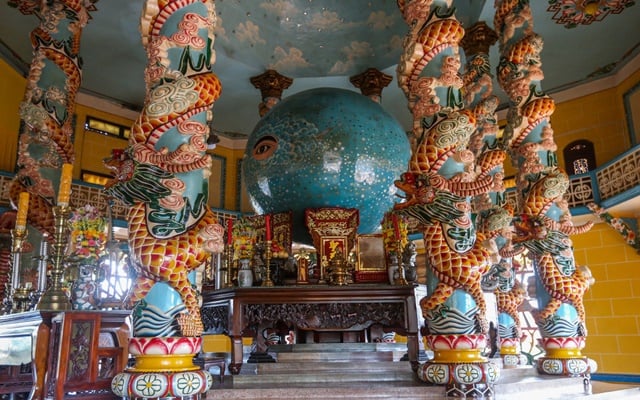Cao Dai Phu Quoc Pagoda
1. Overview
Cao Dai Temple in Phu Quoc is one of the few religious sites on the island that represents the Cao Dai religion – a distinctive Vietnamese faith that blends elements of Buddhism, Taoism, Confucianism, Christianity, and Islam. Located in Duong Dong Town, this colorful and symbolic temple offers visitors a rare glimpse into the spiritual diversity of Vietnam and is a notable destination for those seeking cultural and religious exploration beyond mainstream Buddhism.
2. Historical and Cultural Significance
The Cao Dai religion (Đạo Cao Đài) was founded in 1926 in Tay Ninh Province, southern Vietnam. Its aim is to unify the world’s major religions under one belief system, honoring multiple spiritual figures such as Buddha, Jesus, Lao Tzu, Confucius, and even Victor Hugo.
Though smaller than the famous Cao Dai Holy See in Tay Ninh, the Cao Dai Temple in Phu Quoc plays an important role in the spiritual life of the local Cao Dai community. It serves as a place of worship, moral teaching, and spiritual practice, and also welcomes curious visitors who want to learn about this uniquely Vietnamese faith.
3. Architecture and Design
The architecture of the Cao Dai Temple in Phu Quoc follows the distinctive style of Cao Dai temples across Vietnam:
-
Vibrant Colors: The temple is painted in pastel shades of yellow, pink, and blue, symbolizing purity, harmony, and spiritual enlightenment.
-
Divine Eye Symbol: At the front of the temple is the “All-Seeing Divine Eye”, the main symbol of Cao Dai representing God’s omniscience.
-
Twin Towers: Two towers flank the main hall, often topped with lotus motifs or stylized dragons – symbols of protection and spiritual power.
-
Sacred Hall: Inside the sanctuary, followers pray in white robes, separated by gender, facing the Divine Eye.
-
Cosmic Decorations: The interior is richly decorated with celestial motifs, spiritual symbols, and statues of honored figures from various religions.
Though the temple is modest in size compared to others in Vietnam, it maintains a distinct identity and serves as a visual and spiritual highlight in Duong Dong.
4. How to Get There
The Cao Dai Temple is located on 30 Tháng 4 Street, in Duong Dong Town, Phu Quoc.
-
It is easily reachable on foot from most hotels and guesthouses in central Duong Dong.
-
Alternatively, visitors can use a motorbike, taxi, or bicycle to explore the area.
Its location near the town center makes it a convenient stop for travelers exploring Phu Quoc’s cultural sites.
5. Festivals and Activities
Cao Dai temples follow a specific religious calendar with regular prayer services and major spiritual events, including:
-
Founding Day of Cao Dai (October 7, lunar calendar): A major celebration held annually with prayers and rituals.
-
Daily Ceremonies: Held at fixed times during the day (often at noon), where worshippers chant prayers in a peaceful setting.
-
Tet Holiday: Like other Vietnamese religious groups, Cao Dai followers also honor Lunar New Year with special services and offerings.
Visitors are welcome to observe these ceremonies, though participation is limited to practitioners.
6. Tips for Visitors
-
Dress conservatively: Wear clothes that cover your shoulders and knees.
-
Observe respectfully: Speak quietly, and follow directions if observing ceremonies.
-
Photography is allowed outside and in some parts inside, but avoid flash and always ask for permission when in doubt.
-
Best time to visit: Around midday when the temple may hold ceremonies, or early morning for a quieter experience.
7. Conclusion
The Cao Dai Temple in Phu Quoc stands as a fascinating spiritual and architectural destination. It offers a unique look into a religion born in Vietnam that seeks to harmonize global belief systems. Whether you are spiritually curious or simply interested in local culture, a visit to this colorful and symbolic temple will deepen your understanding of Vietnam’s religious diversity and cultural richness.



